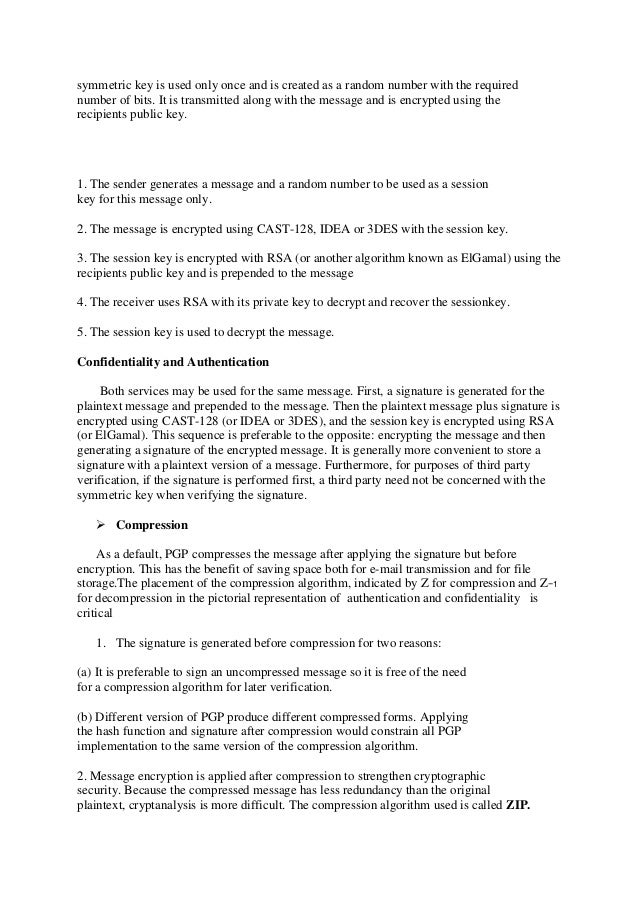A Means Of Generating Predictable Pgp Session Key Is Needed
Posted : admin On 30.05.2020- A Means Of Generating Predictable Pgp Session Key Is Needed Life
- A Means Of Generating Predictable Pgp Session Key Is Needed To Be
Adding private PGP key to key ring. Ask Question Asked 2 years, 11 months ago. Active 2 years, 10 months ago. Viewed 3k times 1. It is my understanding is if a file needs to be decrypted on my server I need to use a private key and give the party sending me the file the public key to encrypt it. The it's reversed if I am to encrypt a key.
Key generation is the process of generating keys in cryptography. A key is used to encrypt and decrypt whatever data is being encrypted/decrypted.
The organization can now install the certificate on their server. When a CA issues the certificate, it binds to a certificate authority’s “trusted root” certificate. When verified, the organization receives a copy of their SSL certificate including business details as well as the public key. The Certificate Authority runs a check on your organization and validates if the organization is registered at the location provided in the CSR and whether the domain exists. Openssl generate public private key.
- Generate session keys could be established without too much difficulty, even non-crippled browsers with 128-bit session keys carried (at best) only 47 bits of entropy in their session keys 15. Shortly afterwards it was found that Kerberos V4 suffered from a similar weakness (in fact it was even worse than Netscape.
- Developments in Cryptography, Public Key Systems The RSA Algorithm. RSA cryptography is used to encrypt messages sent in the PGP email system, on the internet, when you use your mobile phone, and many other everyday events.

A device or program used to generate keys is called a key generator or keygen.
Generation in cryptography[edit]
Modern cryptographic systems include symmetric-key algorithms (such as DES and AES) and public-key algorithms (such as RSA). Symmetric-key algorithms use a single shared key; keeping data secret requires keeping this key secret. Public-key algorithms use a public key and a private key. The public key is made available to anyone (often by means of a digital certificate). A sender encrypts data with the receiver's public key; only the holder of the private key can decrypt this data.
Since public-key algorithms tend to be much slower than symmetric-key algorithms, modern systems such as TLS and SSH use a combination of the two: one party receives the other's public key, and encrypts a small piece of data (either a symmetric key or some data used to generate it). The remainder of the conversation uses a (typically faster) symmetric-key algorithm for encryption.
A Means Of Generating Predictable Pgp Session Key Is Needed Life
Computer cryptography uses integers for keys. In some cases keys are randomly generated using a random number generator (RNG) or pseudorandom number generator (PRNG). A PRNG is a computeralgorithm that produces data that appears random under analysis. PRNGs that use system entropy to seed data generally produce better results, since this makes the initial conditions of the PRNG much more difficult for an attacker to guess. Another way to generate randomness is to utilize information outside the system. veracrypt (a disk encryption software) utilizes user mouse movements to generate unique seeds, in which users are encouraged to move their mouse sporadically. In other situations, the key is derived deterministically using a passphrase and a key derivation function.
Many modern protocols are designed to have forward secrecy, which requires generating a fresh new shared key for each session.
Classic cryptosystems invariably generate two identical keys at one end of the communication link and somehow transport one of the keys to the other end of the link.However, it simplifies key management to use Diffie–Hellman key exchange instead.
The simplest method to read encrypted data without actually decrypting it is a brute-force attack—simply attempting every number, up to the maximum length of the key. Therefore, it is important to use a sufficiently long key length; longer keys take exponentially longer to attack, rendering a brute-force attack impractical. Currently, key lengths of 128 bits (for symmetric key algorithms) and 2048 bits (for public-key algorithms) are common.
Generation in physical layer[edit]
Wireless channels[edit]
A wireless channel is characterized by its two end users. By transmitting pilot signals, these two users can estimate the channel between them and use the channel information to generate a key which is secret only to them.[1] The common secret key for a group of users can be generated based on the channel of each pair of users.[2]

Optical fiber[edit]
A key can also be generated by exploiting the phase fluctuation in a fiber link.[clarification needed]
See also[edit]
- Distributed key generation: For some protocols, no party should be in the sole possession of the secret key. Rather, during distributed key generation, every party obtains a share of the key. A threshold of the participating parties need to cooperate to achieve a cryptographic task, such as decrypting a message.
References[edit]
- ^Chan Dai Truyen Thai; Jemin Lee; Tony Q. S. Quek (Feb 2016). 'Physical-Layer Secret Key Generation with Colluding Untrusted Relays'. IEEE Transactions on Wireless Communications. 15 (2): 1517–1530. doi:10.1109/TWC.2015.2491935.
- ^Chan Dai Truyen Thai; Jemin Lee; Tony Q. S. Quek (Dec 2015). 'Secret Group Key Generation in Physical Layer for Mesh Topology'. 2015 IEEE Global Communications Conference (GLOBECOM). San Diego. pp. 1–6. doi:10.1109/GLOCOM.2015.7417477.